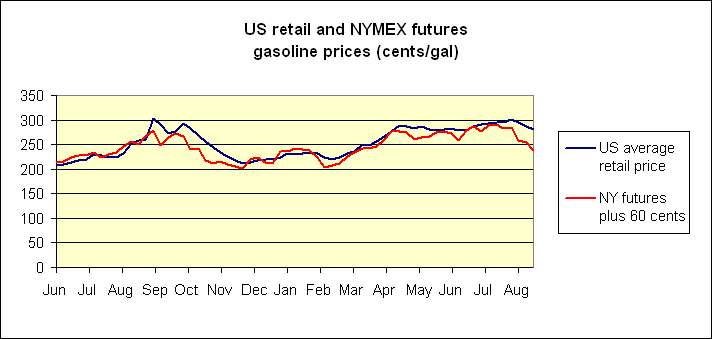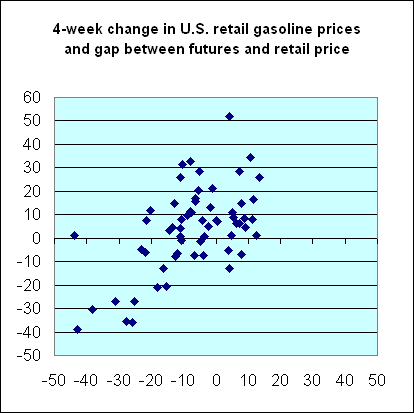U.S. gasoline prices have been dropping and will likely fall further.
There was quite a bit of attention to the declaration by Fred Rozell, gasoline analyst for the Oil Price Information Service, that U.S. gasoline prices will be below $2.50 a gallon by Thanksgiving. Picking up this story, for example, were BloggingStocks, Outside the Beltway, Environmental Economics, Conservative Outpost, and Jay Reding.
This is actually an easier call than might appear. U.S. gasoline prices have a clear seasonal, often falling at the end of the summer driving season. Gasoline also follows crude oil, which is down, and retail prices take some time to adjust to the New York Harbor bulk price, also down. And the NYMEX futures price gives us an advance reading where the latter is likely heading.
 |
The above graph plots the weekly average U.S. retail gasoline price along with the nearest NYMEX futures price plus 60 cents for typical markups and taxes. We’re currently in one of those unusual periods where the two series have diverged significantly, because the futures gasoline price has fallen more quickly than the retail over the last month.
 |
When, as now, the gap is negative, the retail price is likely to fall over the next four weeks. A linear regression fit to the scatter diagram above has a coefficient of 0.77, meaning that with the current gap at about 40 cents per gallon, another 30-cent-per-gallon drop to $2.50 is quite reasonable to predict.
What will this mean for the economy? The economic damage of recent high oil prices so far has been milder than I had anticipated, leaving me to be cautious about predicting too big an economic boost from these anticipated price drops. I have long maintained that to the extent that booming demand was the primary factor bidding oil prices up, that reflects positive, not negative, economic fundamentals. But the reverse dynamics appear to be in play at the moment– the incipient economic slowdown is likely a factor in the recent weakness in oil prices, and that, in itself, is bad news, not good.
Three cheers for falling gasoline prices? At least one, yes, but you might want to keep a couple more in reserve as we wait to see how this plays out.
Technorati Tags: gas prices,
gasoline prices
I understand that there is a level of decorrelation between gas prices and oil prices because of refining and the supply/demand on each side of the refiner (oil in, gas out), but even given that gas prices have seemed cheap to me in contrast to the historical correlation between gas and oil prices, e.g. Gas-Oil Prices
Long term, this chart seems to be saying that gas prices increase by 50 cents/gallon for every $10/barrel increase in oil price. This tells me that gas should be about $3.50 per gallon based upon a $70/barrel oil price. The fact that gas isn’t that high can be explained by the inversion of gas/oil prices that occured around 1980. But in the present case, oil prices really haven’t come down that much. What? $8/gallon.
I’m not arguing that gas won’t drop down to $2.50, but given that I don’t expect oil prices to be dropping as they did around 1981, it seems as if there will be strong upward pressure on gas prices that will keep them from dropping too much.
In summary, it just doesn’t seem like oil prices have dropped that much and given the historical correlation, I’m not convinced we say can much about where prices are headed.
Because of my lack of information (and everybody else’s too), I had assigned a significant probability to the idea that the the oil bubble of the last year was part of the whole commodity bubble and that it was caused by inflationary pressures in the money supply. The question is whether the Fed has turned the screws tight enough to pop the bubbles. Perhaps they have.
Aside from the usual seasonal decline, I think that gas is unlikely to fall too much further. OPEC has gotten the world used to oil at much higher prices than their target was just a few years ago, and will likely try to limit supply if prices fall much more. And all it takes is one rousing speech from Ahmadinejad, the Iranian president, to spook the markets again.
TR Elliot, I understand you don’t expect a drop in oil prices like 1981’s. But keep in mind the strain on demand China’s growth is causing in the market place. If China’s economy takes a big hit, we could see a drop in oil prices that we saw a decade ago.
Keep in mind that oil prices account for only about half to two-thirds of gas prices. Taxes, refining and distribution make up the rest of gas prices, and they are static (or at least do not fluctuate based on oil prices). So if oil prices double, the price of gas does not double. Another way of thinking of it is that tax, refining and distribution adds about $1 to the price of gas, and the rest comes from oil.
This link has a nice explanation of gas prices:
http://www.eia.doe.gov/pub/oil_gas/petroleum/analysis_publications/primer_on_gasoline_prices/html/petbro.html
My point is that you should not look for a linear relationship between oil prices and gas prices. But you can find that linear relationship once you remove $1 for non-oil price components. So when gas is $3/gallon, that means about $2 comes from oil. So if oil skyrockted from $70/barrel up to $140/barrel, we would still only pay $5/gallon, not the $6.50 T.R. Elliott predicts.
Allen: I agree. Oil prices could drop if we see supply getting ahead of demand, for whatever reasons (increased supply, slower demand growth or even demand destruction). I’m just saying they oil prices have not dropped that much. Some, but not much.
Matthew: I understand what you’re saying, but the chart I referenced doesn’t see it your way. Unless I’m reading that chart wrong, it basically says that, long term, a $20/barrel increase in the price of oil equals a $1/gallon increase in the price of gasoline. There are deviations from this trend when (a) oil prices rose fast and (b) oil prices dropped fast. It seems to me we are in one of those periods of rapid price increases. Given my understanding of this graph, a $70 barrel should equal a $4 gallon. To me, it seems like the refining profits must be squeezed right now. The price of oil is up but the price of gas is not up as much as one would expect based upon historical data. I don’t know for sure, but that’s what it looks like to me. Based upon the 50-odd years of data in that chart, gas should be $4/gallon right now. And the chart incorporates all the issues that you raise inherently.
You need to be watching refinery utilization.
During the summer utilization is over 90% and refining margins increase. Once summer demand abates, utilization decreases and the margins become much more competitive. In addition, for gasoline in the US, we go from an oligopoly in the summer to monopolistic competition in the winter. That transition is happening now.
Another factor is the fact that gasoline demand is inelastic. With an inelastic demand, suppliers are going to be reluctant to decrease the price. As refining margins fall, dealer margins increase keeping the price up for a time. Note that the difference between the average retail price and NY futures plus 60 cents only diverge when prices are falling. That represents an increasing dealer margin.
Gasoline prices do indeed move based on crude oil prices. However, they also move based on refining margins which are directly related to refining utilization.
According to Yahoo finance (http://finance.yahoo.com/q?s=RBV06.NYM), the commodity price of gasoline on Friday 9/1/06 traded at 1.78, the Pennsylvania state gasoline tax = .323 and Federal Gasoline Tax = .185, therefore, the ‘fair value’ of gasoline at the pump in Pennsylvania before costs and profits = 1.78 + .323 + .185 = 2.29. In the county where I live (York), pump prices averaged 2.64 and ranged from 2.57 to 2.79. Average markups are 2.64 – 2.29 = .35 per gallon.
Doesn’t the commodity price of gasoline, (not the commodity price of oil) determine the cost of gasoline at the pump? Gas taxes vary greatly from state to state. I don’t know where light sweet crude, RBOB Gasoline Oct ’06 (or any other commodity) prices are headed on Tuesday (or whenever markets again open for trading). However, right now, and every minute of every day in the future that the commodity price of gasoline trades at 1.78 or lower, current pump prices seem too high (by 25 to 30 cents).
Yorkdweeb and others, note that it is a NYMEX futures contract for gasoline, not crude oil, that I am using here. And yes, the specific factors I’m talking about are to some degree moving separately from crude.
I agree we can focus on the price of gasoline, independent of the price of oil, as pointed out above. But I’m still left with this feeling I’ve had for a while that, historically speaking, gas is much less expensive when considering the price of oil at the input.
“Average markups are 2.64 – 2.29 = .35 per gallon.”
What you are seeing is the classic up like a rocket, falls like a feather. The pump price is made up of the futures price plus distribution and dealer margin. The futures price includes the price of crude as well as the refining margin.
The distribution and retailing margin averages about 21 cents. What youre seeing right now is 35 cents which means dealers have increased their margins by about 14 cents.
This is very typical dealer behavior. They increase their margins when the price of gasoline falls. They wont decrease their price until their competition does. If most dealers hesitate to drop their price, then they can all make more money for a while.
For data, have a look at http://tonto.eia.doe.gov/oog/info/gdu/gaspump.html
Convert the percentages to cents per gallon and then look at the refining margin versus the distribution and marketing margin. Month to month they move in opposite directions.
I believe that Goldman Sachs recently reduced the weight of gasoline in its commodity index, coincident with the beginning of the relative price decline of gasoline.